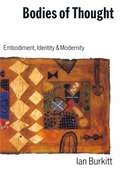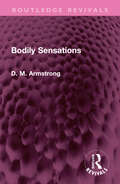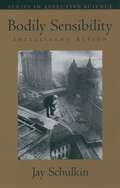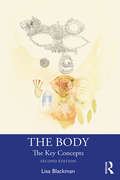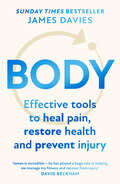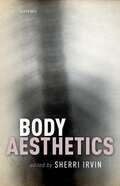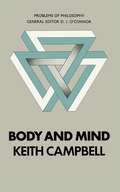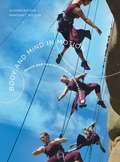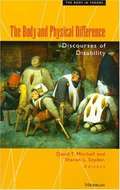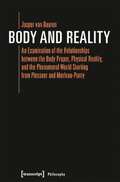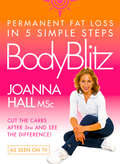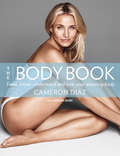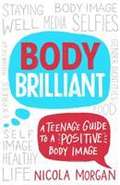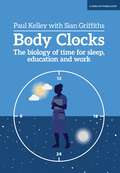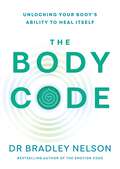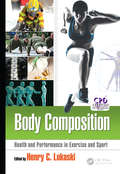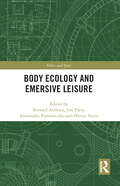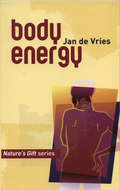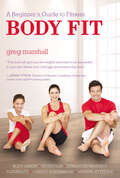- Table View
- List View
Bodies of Thought
by Ian BurkittIn this incisive and truly impressive book, Ian Burkitt critically addresses the dualism between mind and body, thought and emotion, rationality and irrationality, and the mental and the material, which haunt the post-Cartesian world. Drawing on the work of contemporary social theorists and feminist writers, he argues that thought and the sense of being a person is inseparable from bodily practices within social relations, even though such active experience may be abstracted and expanded upon through the use of symbols. Overcoming classic dualisms in social thought, Burkitt argues that bodies are not purely the constructs of discourses of power: they are also productive, communicative, and invested with powerful capacities for changing the social and natural worlds. He goes on to consider how such powers can be developed in more ethical forms of relations and activities.
Bodily Sensations (Routledge Revivals)
by D M ArmstrongFirst published in 1962, Bodily Sensations argues that bodily sensations are nothing but impressions that physical happenings are taking place in the body, impressions that may correspond or fail to correspond to physical reality. In the case of such sensations as pains, these impressions are accompanied by certain attitudes to the impressions. He argues, that is to say that bodily sensations are a sub-species of sense-impression, standing to perception of our own bodily state (or in some cases to touch) as visual impressions stand to the sense of sight. He examines, and tries to refute, all plausible alternative accounts of the nature of bodily sensations. He prefaces his argument by an account of tactual and bodily perception. Here he argues that, with the exception of heat and cold, the qualities discerned by these senses are all reducible to spatial and temporal properties of material objects. Combined with his own conclusions on bodily sensations, this allows him to draw up a short and exhaustive list of the so-called "secondary" qualities of physical objects. This book will be of interest to students of philosophy.
Bodily Sensations (Routledge Revivals)
by D M ArmstrongFirst published in 1962, Bodily Sensations argues that bodily sensations are nothing but impressions that physical happenings are taking place in the body, impressions that may correspond or fail to correspond to physical reality. In the case of such sensations as pains, these impressions are accompanied by certain attitudes to the impressions. He argues, that is to say that bodily sensations are a sub-species of sense-impression, standing to perception of our own bodily state (or in some cases to touch) as visual impressions stand to the sense of sight. He examines, and tries to refute, all plausible alternative accounts of the nature of bodily sensations. He prefaces his argument by an account of tactual and bodily perception. Here he argues that, with the exception of heat and cold, the qualities discerned by these senses are all reducible to spatial and temporal properties of material objects. Combined with his own conclusions on bodily sensations, this allows him to draw up a short and exhaustive list of the so-called "secondary" qualities of physical objects. This book will be of interest to students of philosophy.
Bodily Sensibility: Intelligent Action (Series in Affective Science)
by Jay SchulkinAlthough we usually identify our abilities to reason, to adapt to situations, and to solve problems with the mind, recent research has shown that we should not, in fact, detach these abilities from the body. This work provides an integrative framework for understanding how these abilities are affected by visceral reactions. Schulkin presents provocative neuroscientific research demonstrating that thought is not on one side and bodily sensibility on the other; from a biological point of view, they are integrated. Schulkin further argues that this integration has important implications for judgements about art and music, moral sensibilities, attraction and revulsion, and our perpetual inclination to explain ourselves and our surroundings.
The Body: The Key Concepts
by Lisa BlackmanThoroughly updated and revised throughout with brand new chapters on affective bodies, indeterminate bodies, assemblaged bodies and a new conclusion, and featuring essay and classroom questions for classroom use, The Body: Key Concepts, Second Edition, presents a concise and up-to-date introduction to, and analysis of, the complex and influential debates around the body in contemporary culture. Lisa Blackman outlines and illuminates those debates which have made the body central to current interdisciplinary thinking across the arts, humanities and sciences. Since body studies hit the mainstream, it has grown in new regions, including China, and moved in new directions to question what counts as a body and what it means to have and be a body in different contexts, milieu and settings. Lisa Blackman guides the reader through socio-cultural questions around representation, performance, class, race, gender, disability and sexuality to examine how current thinking about the body has developed and been transformed. Blackman engages with classic anthropological scholarship from Nancy Scheper-Hughes and Margaret Lock, revisits black feminist writings from the 1980s, as well as engaging with recent debates, thought and theorists who are inventing new concepts, methods and ways of apprehending embodiment which challenge binary and dualistic categories. It provides an overview of the proliferation of body studies into other disciplines, including media and cultural studies, philosophy, gender studies and anthropology, as well as mapping the future of body studies at the intersections of body and affect studies.
The Body: The Key Concepts
by Lisa BlackmanThoroughly updated and revised throughout with brand new chapters on affective bodies, indeterminate bodies, assemblaged bodies and a new conclusion, and featuring essay and classroom questions for classroom use, The Body: Key Concepts, Second Edition, presents a concise and up-to-date introduction to, and analysis of, the complex and influential debates around the body in contemporary culture. Lisa Blackman outlines and illuminates those debates which have made the body central to current interdisciplinary thinking across the arts, humanities and sciences. Since body studies hit the mainstream, it has grown in new regions, including China, and moved in new directions to question what counts as a body and what it means to have and be a body in different contexts, milieu and settings. Lisa Blackman guides the reader through socio-cultural questions around representation, performance, class, race, gender, disability and sexuality to examine how current thinking about the body has developed and been transformed. Blackman engages with classic anthropological scholarship from Nancy Scheper-Hughes and Margaret Lock, revisits black feminist writings from the 1980s, as well as engaging with recent debates, thought and theorists who are inventing new concepts, methods and ways of apprehending embodiment which challenge binary and dualistic categories. It provides an overview of the proliferation of body studies into other disciplines, including media and cultural studies, philosophy, gender studies and anthropology, as well as mapping the future of body studies at the intersections of body and affect studies.
Body
by null James DaviesThe Sunday Times bestseller with all the strategies you need to prevent pain and fuel your body to its fullest health potential. ‘James is incredible – he has played a huge role in helping me manage my fitness and recover from injury over the years’ David Beckham Simple techniques and strategies to HEAL From stress and anxiety, to everyday wear and tear and injury, life takes its toll on our bodies. Now, internationally renowned osteopath James Davies can help you heal your body. RESET With tips and tricks to help recognise, manage, and treat everyday aches and pains, this book will reset your approach to understanding your body. James presents a revolutionary blueprint for holistic body wellbeing. RESTORE Improve your wellbeing with exercises expertly designed to optimise your body. Enhance your health and mobility by understanding common conditions from arthritis and muscle strains, to IBS and stress, and empower yourself with the knowledge you need to achieve full-body health. BODY was number 9 in the Sunday Times Bestseller Chart w/b 12th September 2022
Body Aesthetics
by Sherri IrvinThe body is a rich object for aesthetic inquiry. We aesthetically assess both our own bodies and those of others, and our felt bodily experiences-as we eat, have sex, and engage in other everyday activities-have aesthetic qualities. The body, whether depicted or actively performing, features centrally in aesthetic experiences of visual art, theatre, dance and sports. Body aesthetics can be a source of delight for both the subject and the object of the gaze. But aesthetic consideration of bodies also raises acute ethical questions: the body is deeply intertwined with one's identity and sense of self, and aesthetic assessment of bodies can perpetuate oppression based on race, gender identity, sexual orientation, age, size, and disability. Artistic and media representations shape how we see and engage with bodies, with consequences both personal and political. This volume contains sixteen original essays by contributors in philosophy, sociology, dance, disability theory, critical race studies, feminist theory, medicine, and law. Contributors take on bodily beauty, sexual attractiveness, the role of images in power relations, the distinct aesthetics of disabled bodies, the construction of national identity, the creation of compassion through bodily presence, the role of bodily style in moral comportment, and the somatic aesthetics of racialized police violence.
Body Aesthetics (PDF)
by Sherri IrvinThe body is a rich object for aesthetic inquiry. We aesthetically assess both our own bodies and those of others, and our felt bodily experiences-as we eat, have sex, and engage in other everyday activities-have aesthetic qualities. The body, whether depicted or actively performing, features centrally in aesthetic experiences of visual art, theatre, dance and sports. Body aesthetics can be a source of delight for both the subject and the object of the gaze. But aesthetic consideration of bodies also raises acute ethical questions: the body is deeply intertwined with one's identity and sense of self, and aesthetic assessment of bodies can perpetuate oppression based on race, gender identity, sexual orientation, age, size, and disability. Artistic and media representations shape how we see and engage with bodies, with consequences both personal and political. This volume contains sixteen original essays by contributors in philosophy, sociology, dance, disability theory, critical race studies, feminist theory, medicine, and law. Contributors take on bodily beauty, sexual attractiveness, the role of images in power relations, the distinct aesthetics of disabled bodies, the construction of national identity, the creation of compassion through bodily presence, the role of bodily style in moral comportment, and the somatic aesthetics of racialized police violence.
Body and Mind in Motion: Dance and Neuroscience in Conversation (PDF)
by Glenna Batson Margaret WilsonDrawing from the burgeoning field of 'embodiment' – itself an idea at the intersection of the sciences, humanities, arts and technologies – Body and Mind in Motion highlights the relevance of somatic education within dance education, dance science and body-mind studies.
The Body And Physical Difference: Discourses Of Disability
by David T. Mitchell Sharon L. SnyderFor years the subject of human disability has engaged those in the biological, social and cognitive sciences, while at the same time, it has been curiously neglected within the humanities. The Body and Physical Difference seeks to introduce the field of disability studies into the humanities by exploring the fantasies and fictions that have crystallized around conceptions of physical and cognitive difference. Based on the premise that the significance of disabilities in culture and the arts has been culturally vexed as well as historically erased, the collection probes our society's pathological investment in human variability and "aberrancy. " The contributors demonstrate how definitions of disability underpin fundamental concepts such as normalcy, health, bodily integrity, individuality, citizenship, and morality--all terms that define the very essence of what it means to be human. The book provides a provocative range of topics and perspectives: the absence of physical "otherness" in Ancient Greece, the depiction of the female invalid in Victorian literature, the production of tragic innocence in British and American telethons, the reconstruction of Civil War amputees, and disability as the aesthetic basis for definitions of expendable life within the modern eugenics movement. With this new, secure anchoring in the humanities, disability studies now emerges as a significant strain in contemporary theories of identity and social marginality. Moving beyond the oversimplication that disabled people are marginalized and made invisible by able-ist assumptions and practices, the contributors demonstrate that representation is founded upon the perpetual exhibition of human anomalies. In this sense, all art can be said to migrate toward the "freakish" and the "grotesque. " Such a project paradoxically makes disability the exception and the rule of the desire to represent that which has been traditionally out-of-bounds in polite discourse. The Body and Physical Difference has relevance across a wide range of academic specialties such as cultural studies, the sociology of medicine, history, literature and medicine, the allied health professions, rehabilitation, aesthetics, philosophical discourses of the body, literary and film studies, and narrative theory. David T. Mitchell is Assistant Professor of English, Northern Michigan University. Sharon L. Snyder teaches film and literature at Northern Michigan University.
Body and Practice in Kant (Studies in German Idealism #6)
by Helge SvareKant is generally conceived to have offered little attention to the fact that we experience the world in and through our bodies. This book argues that this standard image of the great German philosopher is radically wrong. Not only does Kant - throughout his career and in works published before and after the Critique of pure reason - reflect constantly upon the fact that human life is embodied, but the Critique of pure reason itself may be read as a critical reflection aimed at exploring some significant philosophical implications of this fact. Bringing this aspect of Kant's philosophy into focus is important, not only because it sheds new light on our understanding of Kant's work, but also because it is relevant to contemporary discussions in philosophy about embodiment, learning and practice. By taking his philosophy of embodiment into account, the author makes Kant stand out as a true contemporary in new and unexpected ways.
Body and Reality: An Examination of the Relationships between the Body Proper, Physical Reality, and the Phenomenal World Starting from Plessner and Merleau-Ponty (Edition Moderne Postmoderne)
by Jasper van BuurenIs materialism right to claim that the world of everyday-life experience - the phenomenal world - is nothing but an illusion produced in physical reality, notably in the brain? Or is Merleau-Ponty right when he defends the fundamental character of the phenomenal world while rejecting physical realism? Jasper van Buuren addresses these questions by exploring the nature of the body proper in Merleau-Ponty and Plessner, arguing that physical and phenomenal realism are not mutually exclusive but complementary. The argument includes a close examination of the relationships between scientific and pre-scientific perspectives, between living and non-living things, and between humans and animals.
Body Blitz: 5 Simple Steps To Permanent Fat Loss
by Joanna Hall5 steps to lose weight from ITV’s This Morning’s Fitness and Diet Expert
The Body Book: Feed, Move, Understand And Love Your Amazing Body
by Cameron DiazSuperstar Hollywood actress and former model Cameron Diaz shares her advice on how to become happier, healthier and stronger.
Body Brilliant: A Teenage Guide to a Positive Body Image (PDF)
by Nicola MorganWritten by teenage expert, Nicola Morgan, 'Body Brilliant' will help teenagers to develop or retain a positive body image. We're all bombarded with information and images - through the media and our peers - about being too big, too small, being cool, being popular or having the 'right' kind of clothes. This book addresses the body issues that nearly everyone worries about at some point in their lives and gives practical and mindful solutions to work through worries, using real-life examples, quotes and anecdotes from young adults interviewed especially for this book. 'Body Brilliant' explores psychological pressures that make us see our bodies in certain ways, positively or negatively, as well as considering how adolescent body changes, gender identity and gender expectations, sexuality and sexual orientation affect self-image, and looks at issues such as body dysmorphia and eating disorders. 'Body Brilliant' also encourages you to think about how you view differences in others and understand that variety is a brilliant thing. And that being yourself is much better than being just like everyone else. Learn to celebrate the differences that make every body brilliant!
Body Clocks: The biology of time for sleep, education and work
by Paul Kelley Sian GriffithsOur body's clocks make the difference between happiness and depression, health and illness, and even life and death. The brilliant scientist Paul Kelley makes a compelling case for all organisations to allow people to work and study the hours that suit their personal circadian rhythms. That way, Paul argues, we would all be more productive, a great deal of ill health would be avoided and the world would be a better and happier place.
The Body Code: Unlocking your body’s ability to heal itself
by Dr Bradley NelsonHeal yourself in body and mind The Body Code is a truly revolutionary method of holistic healing. Dr. Bradley Nelson, a globally renowned expert in bioenergetic medicine, has spent decades teaching his powerful self-healing method and training practitioners around the globe, but this is the first time his system of healing will be available to the general public in the form of The Body Code.The Body Code is based on the simple premise that the body is self-healing and knows what it needs in order to thrive and flourish. The Body Code method allows readers to tap into this inner knowing, and find imbalances in 6 key areas - Energies, Circuits and Systems, Toxicity, Nutrition and Lifestyle, Misalignments, and Pathogens - that are the root causes of our physical, mental and emotional issues. By identifying and releasing these imbalances, readers become empowered to activate their body's innate healing power.Filled with powerful first-hand accounts of healing, hundreds of colour illustrations, and concrete, actionable steps, The Body Code is a road map to healing based in deep study of the human body, time-proven ancient practices, and the unlimited power of the subconscious mind.
Body Composition: Health and Performance in Exercise and Sport
by Henry C. LukaskiInterest in the relationships between body structure and function in physical activity has persisted for centuries. Body Composition: Health and Performance in Exercise and Sport advances understanding beyond simple descriptions of body physique and composition of athletes and fills gaps in our understanding of the important role of muscle, fat, and bone in facilitating physical performance and health in sports and physically demanding occupations. lt addresses basic, practical, and applied topics in body composition, performance, and health with comprehensive reviews organized in four logical parts: Body Composition Assessment; Physical Activity and Body Composition; Body Composition in Sports and Occupations; and Moderating Factors. This book integrates state-of-the-art knowledge by international experts in the field and produces an evidence-based practical guide for a balanced understanding of the role and use of body composition assessment in physical performance and health for youth and adults. It also provides a needed link between the practice of body composition assessment and its application by members of public health advisory committees that develop national guidelines for diet, physical activity, and health. This book is suitable for students and professionals in sports nutrition, exercise science, kinesiology, and athletic training. Sport administrators and policy-makers for international and national sport federations and organizations, and national intercollegiate and scholastic federations, would also benefit from this book.
Body Composition: Health and Performance in Exercise and Sport
by Henry C. LukaskiInterest in the relationships between body structure and function in physical activity has persisted for centuries. Body Composition: Health and Performance in Exercise and Sport advances understanding beyond simple descriptions of body physique and composition of athletes and fills gaps in our understanding of the important role of muscle, fat, and bone in facilitating physical performance and health in sports and physically demanding occupations. lt addresses basic, practical, and applied topics in body composition, performance, and health with comprehensive reviews organized in four logical parts: Body Composition Assessment; Physical Activity and Body Composition; Body Composition in Sports and Occupations; and Moderating Factors. This book integrates state-of-the-art knowledge by international experts in the field and produces an evidence-based practical guide for a balanced understanding of the role and use of body composition assessment in physical performance and health for youth and adults. It also provides a needed link between the practice of body composition assessment and its application by members of public health advisory committees that develop national guidelines for diet, physical activity, and health. This book is suitable for students and professionals in sports nutrition, exercise science, kinesiology, and athletic training. Sport administrators and policy-makers for international and national sport federations and organizations, and national intercollegiate and scholastic federations, would also benefit from this book.
Body Ecology and Emersive Leisure (Ethics and Sport)
by Bernard Andrieu Jim Parry Alessandro Porrovecchio Olivier SirostThe emerging field of body ecology offers fresh insights into how the body engages with its surrounding environment through consciousness, perception, knowledge and emotion. In this groundbreaking collection, leading scholars of sport, leisure and philosophy draw on research on topics as diverse as surfing, freediving, slacklining, parkour, bodybuilding, dance and circus arts to flesh out the concept of body ecology and its potential for helping us understand our connection with the world around us. Touching on theories of subjectivity, embodiment, pleasure and play, this book explores different approaches to studying body ecology as a way of conceptualising the experience of being immersed in nature, in the elements and in one’s own body through the power of awareness. An experience becomes emersive when it involves the production of new emotions in the body: emersion is the activation of what is living within the body itself. Shedding new light on the possibilities of physical cultural studies, Body Ecology and Emersive Leisure is fascinating reading for all students and scholars with an interest in sport, leisure, philosophy and the body.
Body Ecology and Emersive Leisure (Ethics and Sport)
by Bernard Andrieu Jim Parry Alessandro Porrovecchio Olivier SirostThe emerging field of body ecology offers fresh insights into how the body engages with its surrounding environment through consciousness, perception, knowledge and emotion. In this groundbreaking collection, leading scholars of sport, leisure and philosophy draw on research on topics as diverse as surfing, freediving, slacklining, parkour, bodybuilding, dance and circus arts to flesh out the concept of body ecology and its potential for helping us understand our connection with the world around us. Touching on theories of subjectivity, embodiment, pleasure and play, this book explores different approaches to studying body ecology as a way of conceptualising the experience of being immersed in nature, in the elements and in one’s own body through the power of awareness. An experience becomes emersive when it involves the production of new emotions in the body: emersion is the activation of what is living within the body itself. Shedding new light on the possibilities of physical cultural studies, Body Ecology and Emersive Leisure is fascinating reading for all students and scholars with an interest in sport, leisure, philosophy and the body.
Body Energy: A Complete Guide To Using The Major Forms Of Healing For Body, Mind And Spirit
by Jan De VriesBody Energy is the first book in Jan de Vries' outstanding new health series, Nature's Gift, and is intended to show how the body's energies can be used to combat ailments from headaches to spinal problems. Even the most healthy of us can benefit from an increase in energy; a physical and mental boost encouraged by attitude and action. In this book, Jan de Vries outlines, with the help of drawings and photographs, detailed exercises which may be used to increase body energy. He describes the harnessing of energy through the mind, eyes, hands, bones and muscles, as well as through nutrition. Body Energy is a triumph - available to us all.
Body Fit: A Beginner's Guide to Fitness
by Greg MarshallA comprehensive fitness guide written by a professional trainer for the fitness beginner, covering body image, nutrition, strength training, flexibility, cardio endurance and mental attitude.
